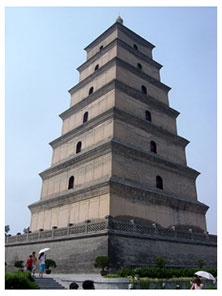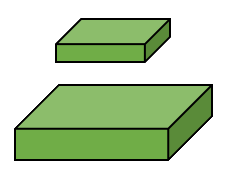
Source: ChinaTrip2005-110, Bobak Ha’Eri, Wikimedia Commons

Source: ChinaTrip2005-110, Bobak Ha’Eri, Wikimedia Commons
The Giant Wild Goose Pagoda in Xi’an, China, is a 65-meter tall structure composed of a sequence of right rectangular prisms with square bases resting
on a concrete pedestal.
The bottom prism of the pagoda is a square with a side length of 33.5 meters. The top prism of the pagoda is a square with a side length of 12.2 meters. Each prism has the same height, which is 9.3 meters.
How much more volume does the bottom prism
have than the top prism?
The bottom prism has a square base. The length and width of the square are both 33.5 meters, and the height of the prism is 9.3 meters. The top prism has a square base. The length and width of the square are both 12.2 meters, and the height of the prism is 9.3 meters.
Keith's Plan
The volume of a prism can be found using the formula, V = Bh, where B represents the area of the base and h represents the height of the prism. These are square prisms, so I’ll use the area formula of a rectangle, A = bh, to calculate the area of the base of the prism. Then, I can subtract the volumes of the two prisms to determine the difference in their volumes.
Use the volume formula for a prism, V = Bh. Since the base is a square, use the area formula for a rectangle, A = bh since a square is a special type of rectangle..
Write an equation that you could use to calculate the area of one stained glass window.
Top prism: V = (12.2 meters)(12.2 meters)(9.3 meters)
Bottom prism: V = (33.5 meters)(33.5 meters)(9.3 meters)
 Volume of the top prism:
Volume of the top prism:
V = (12.2 m)(12.2 m)(9.3 m)
= 1384.212 m3
Volume of the bottom prism:
V = (33.5 m)(33.5 m)(9.3 m)
= 10,436.925 m3
Difference:
10,436.925 m3 – 1384.212 m3
= 9052.713 m3
Strategy check: Use rounding to estimate your answer. Round 12.2 meters, 33.5 meters, and 9.3 meters to the nearest 10 meters.
12.2 meters → 10 meters
33.5 meters → 30 meters
9.3 meters → 10 meters
Volume of the top prism: V ≈ (10 m)(10 m)(10 m)= 1,000 m3
Volume of the bottom prism: V ≈ (30 m)(30 m)(10 m)= 9,000 m3
Difference: 9,000 m3 - 1,000 m3 = 8,000 m3
The estimate of 8,000 m3 is close to the actual answer of 9052.713 m3, so the answer is reasonable.